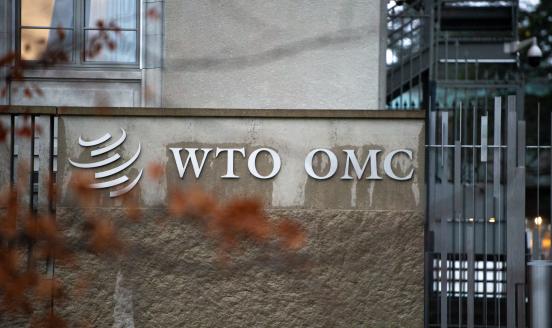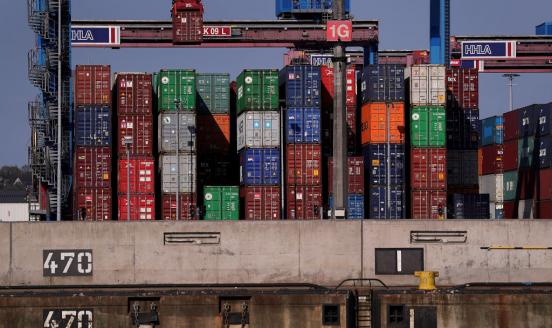Implications of the Japan – United States Mini Trade Agreement
Details of the US-Japan mini-trade deal are lacking but the agreements’ direct impact on the US and Japanese economies is likely to be minuscule. The

On 25th of September, President Trump and Prime Minister Abe concluded a partial trade-agreement whose main provisions are to reduce Japan’s tariffs on some agricultural goods and to reduce US tariffs on certain industrial goods. The agreement also encompasses a digital trade chapter. Because the US tariffs to be reduced are small, under 5%, they can be cut by Presidential proclamation without ratification by the US Congress under Section 103 of the Trade Priorities and Accountability Act of 2015. This little-known statute has existed in various forms over the last several decades. It is intended to promote speed and efficiency in rationalising tariff schedules, but this is the first time that it has been used to conclude a trade deal with a major partner.
The detail of the agreement is lacking, but it is evident based on the fact-sheet circulated by the US Trade Representative that the agreements’ direct impact on the huge US and Japanese economies is likely to be minuscule. Politically powerful US farmers for whom improved access in Japan’s markets matters will gain, and companies engaged in digital trade will be reassured, but nearly all other sectors of the Japanese and American economies will be only marginally affected. The negative competitive implications for third parties – notably the European Union – are smaller still, and they consist mainly of eroding the agricultural preferences the EU gained through its recently concluded FTA with Japan. However, the deal is more important than meets the eye: it carries systemic implications, and nearly all are bad.
This note reviews the effects of the deal that can be quantified. It then reviews the implications of the agreement for a) the prospects that the United States will levy automobile tariffs b) the WTO and its rules on bilateral agreements c) the role of the Congress in the conduct of trade policy in the United States.
Quantifiable Effects
The United States is an essential market for Japanese manufacturers, amounting to 130$ billion, or about 20% of Japan’s exports in that sector. However, automobiles and parts, which represent over 40% of those exports are excluded from the agreement. The average tariff faced in the United States by the rest of Japan’s manufactures exports (i.e. excluding automobiles and parts) is just 1.3%. Although there is a large overlap between Japan’s and the European Union’s manufactures exports to the United States (44%)[1], the small preferences that Japanese producers gain are unlikely to have a significant impact on competitive positions of Europeans.
Japan is a significant market for US farmers, especially in products such as corn ($2.8 billion), pork meat ($1.5 billion) and beef ($1.2 billion). US agricultural exports to Japan amount to $15,2 billion or 9.3% of the nation’s total agriculture exports. Moreover, unlike in the manufacturing sectors, Japan’s MFN applied tariffs on agricultural products are high. For example, beef faces an average tariff rate of 38%. Japan’s concessions include a more generous treatment of beef and other agricultural products, but the concessions overall fall short of those agreed in the agriculture chapter of the TPP and given to Japan’s partners in the Comprehensive and Progressive Agreement for Trans-Pacific Partnership (CPTPP)[2].
The EU’s agriculture exports to Japan represent just about half those of the United States, and the overlap (19%) is far less than in manufactures. Still, the preference erosion in sectors of importance to Europeans, such as wine, other alcoholic beverages, dairy and processed foods may be keenly felt by some firms.
The deal’s digital trade chapter, in which both Japan and the United States have a strong interest, is modelled on the US Mexico Canada Agreement. It includes commitment to barrier-free cross-border data transfers, duty-free trade in digital products and prohibits data localisation requirement. The effect of these provisions is not quantifiable, but the deal strengthens disciplines in an area of growing importance and may contribute to their broader acceptance.
Automobiles
The big surprise is that the Japanese failed to secure any firm assurance that the Trump Administration will refrain from carrying out its threat to impose tariffs on imported automobiles from Japan in exchange for their concessions in agriculture. Obtaining that assurance had been Prime Minister Abe’s main objective in agreeing to launch the negotiations. In the joint press conference with President Trump at the signing of the agreement, automobiles were not even mentioned. The joint Japan-US declaration issued on the same day gives only the mildest comfort to the Japanese. The declaration reads: “…both nations will refrain from taking measures against the spirit of these agreements and this Joint Statement. In addition, both nations will make efforts for an early solution to other tariff-related issues”. Some have read in the text the implication that, if the US imposes auto tariffs invoking national security under the Trade Expansion Act of 1962, the Japanese have the legal space to withdraw their concessions in agriculture.
The omission of automobiles in the mini deal reveals just how committed President Trump is to maintain the threat of auto tariffs as an instrument of his trade policy[3]. Had he agreed to provide the Japanese cover on this issue, it would have been hard for him to argue that European cars represent a threat to national security, but the Japanese do not.
Still, having just signed a deal with Japan, it is unlikely that the President will impose auto tariffs on Japanese cars before the 14 November deadline set by law and which marks six months after the report by the Commerce Department. As expressed in a recent Bruegel note (Dadush, 2019), it is unlikely anyway that auto tariffs will be declared in the run-up to a Presidential election, because they would be felt immediately by consumers and prove politically very costly. However, auto tariffs remain a live threat should the President be reelected. In that scenario, Japan’s willingness to concede on agriculture even without assurances on auto tariffs strengthens the hand of American negotiators who will insist that Europeans must negotiate on agriculture to maintain their access to America’s car market.
WTO Article 24
The Japan-US mini deal represents a significant departure in American Trade Policy. More than any other nation, the United States had insisted that its regional and bilateral trade deals be high-quality and comprehensive. This is in keeping with Article 24 of the WTO, which requires the coverage of “substantially all trade”. Article 24 guards against the temptation to negotiate tariff reductions selectively to gain an advantage over third parties. The “substantially all trade” provision is also intended to make bilateral deals, which are inherently discriminatory, hard to do.
By promising to extend the mini deal in the future, the US and Japan have provided themselves with a thin veil of WTO compliance. But there is no certainty that a comprehensive agreement can be negotiated successfully and ratified. Thus, the mini deal is yet another sign that the United States Administration is discarding WTO disciplines when it suits. The fact that Japan, a staunch defender of the rules-based system, has become a party to such an agreement – whether willingly or reluctantly – underscores the power of the United States and the gravity of its defection from the multilateral system. But Japan was not the first to walk down this path. The precedent was already established by the Juncker-Trump meeting of July 2018, when Europeans advocated narrowing negotiations with the United States to manufactures. Had that deal been concluded, it would also have been in clear violation of WTO Article 24.
Role of Congress and Geopolitics
The Japan-US deal marks another milestone in the executive branch’s dominance of American trade policy. The United States Congress will have no say on a trade deal with the world’s fourth-largest economy. And Trump now wields with abandon tariffs and trade remedy instruments as weapons. Congress, in whom the constitutional authority for trade policy rests, retains its veto power over major agreements such as the US-Mexico-Canada Agreement (USMCA), which is currently the object of a ratification fight, but has faded into the background in nearly all other matters of trade strategy[4].
The delegation of trade authority to the President, dating back to 1934, was intended to reduce the influence of protectionist interests in the Congress. That lead to big changes, marking the dawn of a far more liberal trade policy that, by and large, successfully promoted the general interest. Unfortunately, under Trump, American trade policy has suffered the unintended consequence of becoming the province of the President himself, catering to his prejudices and whims. Not surprisingly, it has now become an instrument of choice to promote his re-election. The main objective of the Japan US mini deal is not to rationalise trade relations, but to compensate American farmers – a crucial electoral base of the President –for their losses from the trade war with China.
On its part, Japan’s acquiescence to what many believe is an unbalanced agreement can be ascribed to its dependence on the American security umbrella against the threats Japan perceives from China and North Korea. Meanwhile, the United States’ trade war with China owes as much to an intensifying power struggle as to economic calculus.
Buffeted by electoral politics in the world’s largest economy and by geopolitical rifts among its main stakeholders, it is difficult to see how the rules-based international trading system can be sustained. That is perhaps the most important lesson to draw from the partial Japan-US trade deal.
References
Cohen-Setton, J. (2019), ‘Uncertainty over Auto Tariffs May Not End Soon’, Peterson Institute For International Economics, available at https://www.piie.com/blogs/trade-investment-policy-watch/uncertainty-over-auto-tariffs-may-not-end-soon
Finger, J. M., and M. E. Kreinin. “A Measure of `Export Similarity' and Its Possible Uses.” The Economic Journal, vol. 89, no. 356, 1979, pp. 905–912. JSTOR, www.jstor.org/stable/2231506.
UN Comtrade (2019), UN Comtrade database, accessed on the 25/09/2019, available at https://comtrade.un.org/data/.
United States Senate Committee on Finance (2018), ‘Breaking Down Section 232 of the Trade Expansion Act of 1962’, United States Senate, available at https://www.finance.senate.gov/chairmans-news/breaking-down-section-232-of-the-trade-expansion-act-of-1962#targetText=Section%20232%20of%20the%20Trade,security%20of%20the%20United%20States.
USTR (2019), “FACT SHEET: U.S.-Japan Trade Agreement”, website of the Office of the United States Trade Representative, available at https://ustr.gov/about-us/policy-offices/press-office/fact-sheets/2019/september/fact-sheet-us-japan-trade-agreement
White house (2019), ‘Joint Statement of the United States and Japan’, Statements and releases, available at https://www.whitehouse.gov/briefings-statements/joint-statement-united-states-japan-2/
White house (2019), ‘Presidential Message to Congress Regarding the Notification of Initiation of United States–Japan Trade Agreement’, Statements and releases, available at https://www.whitehouse.gov/briefings-statements/presidential-message-congress-regarding-notification-initiation-united-states-japan-trade-agreement/
White house (2019), ‘Remarks by President Trump and Prime Minister Abe of Japan in Signing of Joint Trade Agreement’, Remarks, available at https://www.whitehouse.gov/briefings-statements/remarks-president-trump-prime-minister-abe-japan-signing-joint-trade-agreement-new-york-ny/
Notes
[1] Overlaps in goods which countries A and B are both exporting to country C, are calculated following Finger and Kreinin (1979). If the commodity distribution of A’s and B’s exports are identical the overlap rate will be 100%, if they are completely dissimilar it will be 0%. The rate is constructed as the sum of all matches at a HS 6-digit level, each match’s contribution being the minimum between the share the good represents in country A export mix to country C and the share the good represents in that of country B.
[2] Agricultural products that were initially included in TPP and not present in the current deal include important imports in Japan. For instance, products that were initially in the TPP agreement but are not mentioned in the USTR fact-sheet include prepared and preserved poultry, rice and rice products, milk powder, seafoods, apples, and butter. These items combined represent about 14.3$ bn of Japanese imports in 2018 of which 1.6$ bn. was from the US.
[3] It is noteworthy that automobiles and parts were not included in the list of products on which the US will retaliate in the wake of the WTO’s ruling against the EU in the Airbus subsidy case. This should not be read as a change of heart of the Trump Administration on automobile tariffs, instead as a decision to keep the issues separate. When and if auto tariffs are imposed, the EU exports affected will be a multiple of the $7.5 billion affected by the WTO ruling.
[4]The President will retain Trade Promotion Authority – the right to present Congress with trade agreements for ratification on a yes or no basis, i.e. without amendment, until June 2021, when it will come up for renewal.



